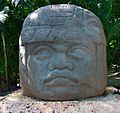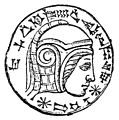500s BC facts for kids
| Millennium: | 1st millennium BC |
| Centuries: | 7th century BC – 6th century BC – 5th century BC |
| Decades: | 530s BC 520s BC 510s BC – 500s BC – 490s BC 480s BC 470s BC |
| Years: | 509 BC 508 BC 507 BC 506 BC 505 BC 504 BC 503 BC 502 BC 501 BC 500 BC |
| Categories: | Births – Deaths – Architecture Establishments – Disestablishments |
The 500s BC was a time of big changes around the world! New ways of governing started, like the Roman Republic, and important ideas about how people should live and think spread across different lands. Many ancient civilizations were growing and interacting, leading to new empires, battles, and discoveries.
Contents
Major Events of the 500s BC
New Governments and Leaders
- 509 BC: The Roman Republic began! This was a new way of ruling where citizens had more say, instead of just one king.
- 509 BC, September 13: A very important building, the Temple of Jupiter on Rome's Capitoline Hill, was officially opened.
- 508 BC: The job of pontifex maximus was created in Rome. This was the chief priest, a very powerful religious leader.
- 507 BC: A Greek reformer named Cleisthenes took power in Athens. He made big changes to increase democracy, giving more people a voice in how the city was run.
- 505 BC: The first two Roman consuls were chosen in Rome. Consuls were like presidents who led the Republic.
- 501 BC: Because of threats from the Sabines, Rome created the job of dictator. A dictator was a temporary ruler with total power, used only in emergencies.
- c. 500 BC: The first republic in Vaishali, Bihar, India, began. This shows that different parts of the world were exploring similar ideas about government.
Battles and Conflicts
- 506 BC: In the Battle of Bai ju, the army of the Kingdom of Wu, led by the famous general Sun Tzu, defeated the forces of Chu.
- 502 BC: The Latin League, a group of cities allied with Rome, defeated the Etruscans near Aricia. This was an important victory for the growing Roman power.
- 502 BC: The city of Naxos rebelled against the powerful Persian Empire. This rebellion helped start the Ionian Revolt, a big conflict between the Greeks and Persians.
- 501 BC: The Persian Empire attacked Naxos in response to its rebellion.
- c. 500 BC: Gadir (which is now Cádiz in Spain) was captured by Carthage. Carthage was a powerful city in North Africa, known for its strong navy and trade.
Science and Culture
- 502 BC, December 4: Scientists believe a Solar eclipse made the sky dark over Egypt. We know this from studying patterns of eclipses, even if there isn't a clear historical record.
- 500 BC: Darius I, the powerful ruler of Persia, declared that the Aramaic language would be the official language for the western part of his huge empire.
- c. 500 BC: The oldest known writing from the Zapotec civilization in Mesoamerica was created. This shows how advanced their culture was.
Changes in Human History
- 500 BC: Bantu-speaking people started moving into southwest Uganda from the west. This was part of a large migration that spread Bantu languages and cultures across Africa.
- 500 BC: The Nordic Bronze Age ended in northern Europe, and the Pre-Roman Iron Age began. This means people started using iron tools and weapons instead of bronze.
- c. 500 BC: The Yayoi period began in Ancient Japan. This period saw new farming methods and pottery styles.
Important People of the 500s BC
- c. 500 BC: Heraclitus was an Ancient Greek philosopher. He is famous for his idea that everything is always changing.
- Siddharta Gautama was a spiritual teacher and the founder of Buddhism. His teachings about peace and understanding spread widely.
- c. 585–501 BC: Pythagoras was a famous mathematician and philosopher from Ancient Greece. He is known for the Pythagorean theorem in geometry.
- Confucius was a very important Chinese teacher and philosopher. Around 501 BC, he became governor of Chung-tu, where he put his ideas about good government into practice.
People Who Died in the 500s BC
- Lucretia: A Roman noblewoman whose story is linked to the start of the Roman Republic.
- Lucius Junius Brutus: A Roman consul who helped establish the Roman Republic in 509 BC.
- Aruns Tarquinius: A Roman prince who died in 509 BC.
- Shen Yin Shu: A general from the state of Chu, who died in 506 BC.
- Titus Junius Brutus and Tiberius Junius Brutus: Roman nobles who were involved in a plot to bring back the monarchy.
How the World Looked
Images for kids
-
Monument 1, an Olmec colossal head at La Venta
-
An engraving on an eye stone of onyx with an inscription of Nebuchadnezzar II
-
Medieval image of Thales
-
Croesus on the pyre, Attic red-figure amphora
-
Faravahar, a symbol of Zoroastrianism in Persepolis
-
Image of Laozi
See also
 In Spanish: Siglo VI a. C. para niños
In Spanish: Siglo VI a. C. para niños

All content from Kiddle encyclopedia articles (including the article images and facts) can be freely used under Attribution-ShareAlike license, unless stated otherwise. Cite this article:
500s BC Facts for Kids. Kiddle Encyclopedia.










